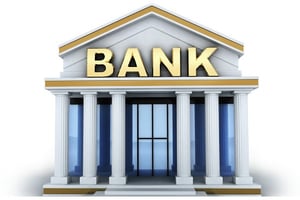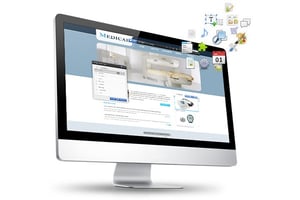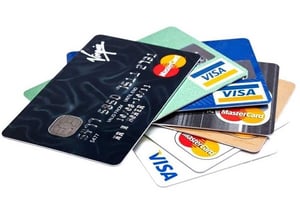In our digital age it’s easy to monitor your credit card accounts online. But are you taking every precaution to protect those accounts from phishing attacks? Many people are so busy and pressed for time that they assume that every email they receive from their credit card company is legitimate. The backbone of any successful phishing attack is a well-designed spoofed email or spoofed website, which is why it pays to have a healthy level of skepticism when it comes to opening emails and visiting websites. Learn more about the basics of credit card phishing scams by checking out the following information!
Email Alerts that Lead to TroubleYou are probably used to receiving occasional emails from your credit card company. That is precisely what phishers are banking on: that you won’t recognize a spoofed email before it is too late. Most of the messages that you receive from your credit card company are probably friendly reminders and sales pitches. If you receive a message that has an unusual level of urgency, however, you should be extremely careful. Phishing attacks usually involve spoofed emails that include a lot of urgent language. That urgency is used to prompt quick, unquestioning action from the recipient, which often leads to serious trouble.
Clicking on Links in a Spoofed EmailAlthough spoofed emails sometimes include forms that request personal information, they are more likely to contain links that lead to spoofed websites. This is why you should never click on a link in an email from your credit card company, even if you think that it is legitimate. It only takes a few extra seconds to open a new tab in your browser, manually type in the credit card company’s URL and log into your account. If a truly urgent situation exists, you will learn more about it after logging into your online credit card account.
Spoofed Credit Card WebsitesSpoofed credit card websites can be extremely well done. Even if you visit your credit card company’s website on a regular basis, it is all too easy to be fooled. Phishers use many sophisticated techniques to make spoofed websites that look eerily similar to their legitimate counterparts. In the rush to find out what is wrong, it is easy to fall right into phishers’ traps. The consequences of doing that can be dire.
Avoid Serious ConsequencesIf you fall victim to a credit card phishing scam, the perpetrators can gain access to your credit card numbers and a lot of other personal information. They can use your credit card to go on shopping sprees, and they can use your personal information to steal your identity. From there, they can attempt to open new accounts and wreak all sorts of other havoc. You can avoid phishing scams by being conscientious of the threat of phishing attacks and by protecting your sensitive information at all costs.
 Bank Phishing Scams
Bank Phishing Scams
Bank customers are popular targets of those who engage in phishing attacks. If you have a bank account, you more than likely access it online from time to time. As a result, you probably have a username and a password that are associated with your online account. Most people understand the importance of keeping that kind of information confidential; if it falls into the wrong hands, a great deal of sensitive financial information would be compromised. Unfortunately, many people fall victim to bank phishing scams each year and inadvertently give out sensitive information to people who have criminal activities on their minds.
Spoof Bank EmailsThe most common way that a phisher gets the ball rolling on a bank phishing attack is by sending out thousands of spoof emails. These emails are carefully crafted to look nearly identical to the types of correspondence that are sent out by actual banks. Skilled phishers can replicate the logos, layout and general tone of such emails to uncanny degrees. They bank on the fact that most people are quite busy; at a glance, these spoof emails appear to be legitimate. As a result, recipients are more likely to take what is written in them seriously.
One way to avoid falling victim to spoof bank emails is by looking at them closely. Never assume that such messages originate from legitimate sources. Be especially vigilant if the email requests information from you. For one thing, no legitimate bank is going to include a form within an email that they send to you. This is a well-known phishing ploy and it should raise a big red flag for you. Look closely at the sender’s email address as well. Above all else, double-check on the actual bank’s website or give the bank a call if you are in doubt.
Spoof Bank WebsitesSpoofed bank emails almost always include links that will take you to spoofed bank websites. Like spoof emails, spoof bank websites look nearly identical as their legitimate counterparts. One telltale sign of a spoofed bank website is a popup window that demands various types of credentials. There are many scripts that phishers can use to make these popup windows appear, and real banks never use them. Never follow a link to your bank’s website. Always type the URL manually into your browser’s address bar or give them a call to check on your accounts.
Chase Bank Phishing ScamOne of the most famous examples of a bank phishing scam involved Chase. Phishers especially went to town when Bank One of Indiana was bought out by the huge bank. Phishers obtained the email addresses of thousands of Bank One customers and used the changeover as a ruse in order to cull sensitive information from the victims. Like so many other phishing scams, these emails and fake phishing websites included a lot of urgent language. They implied that customers needed to supply the requested information right away or lose access to their accounts, which would certainly be a cause for alarm.
The Chase bank phishing scam is a prime example of just how easy it is for people to fall into phishers’ traps. Actual Chase logos were used in the emails, which made it even trickier to tell them apart from spoofs. You can be sure that future bank phishing scams will use even sneakier and more sophisticated methods. Whenever you receive an important email from your bank, make a point of logging on to its website. Do not follow a link to the bank website; instead, type in the URL manually. If something important really needs your attention, you should be alerted about it somewhere on the online interface. If questions persist, pick up the phone and contact your bank. You can’t be too careful when it comes to protecting your financial information from phishing attacks.
 Email Phishing Scams
Email Phishing Scams
A spoofed email message is often the cornerstone of any well-executed phishing scam. From the earliest days of phishing, fraudulent email messages have been used to catch Internet users unawares. Phishing attacks picked up steam during the heyday of AOL. Instant messages and email messages were used to carry out those attacks. Although many things have changed, many others have remained the same. To this very day, major online entities like PayPal and eBay have to grapple with the problem of email phishing. Learn more about how email phishing works, what it looks like and how avoid falling victim to it below.
What is Email Phishing?Email phishing refers to the act of creating and sending fraudulent or spoofed emails with the goal of obtaining sensitive financial and personal information. Under such schemes, emails are designed to look exactly like the ones that are sent by legitimate companies. Sophisticated phishing attacks use the email addresses of people who are registered to use certain services. When those people receive emails that are supposed to be from those companies, they are more likely to trust them. Spoofed emails often contain links that lead to spoofed websites, where various methods are used to request and collect a person’s financial and personal information. Forms are occasionally contained within the emails themselves too.
Why Email Phishing WorksConsidering how long email phishing has been used, it may seem odd that it continues to work. It isn’t because people are foolish; it is because these emails are very well done. Phishers know precisely how to design spoofed emails to look like their legitimate counterparts. By throwing in some urgent language, phishers dramatically increase their odds of success. Busy people scan such emails, trust them and click on their links because they look almost exactly like the real thing. One wrong click can lead to a world of hurt.
Signs of Email PhishingThere are many signs of a phishing email. The first thing that you should look at is the greeting. Does it use your actual name, or does it have a generic greeting? Look closely at the email’s header. What is the sender’s email address? These addresses are usually carefully designed to look authentic. By taking a very close look at them, though, you can usually see inconsistencies and things that don’t make sense. If possible, compare the sender’s email address to that of previous messages from the same company. If it’s a phishing email, you will notice things that don’t add up.
Examples of Successful Email PhishingMany successful email phishing attacks have been carried out in the past, which is why they continue to be used to this day. Prominent examples include eBay phishing scams and PayPal phishing scams. Both companies were prime targets of email phishing campaigns in the past. eBay and PayPal users receive messages that look legitimate. The messages typically urge them to verify their account information or to update their credit card numbers. People often fall for these ruses because they are afraid of losing access to these important services. Both companies now offer extensive information on ways to avoid such phishing scams on their websites.
There is no simple way to completely avoid email phishing attacks. Sooner or later, someone is bound to send you a spoofed email. The easiest way to avoid these scams is by never clicking on links that are included in email messages. Make it a policy to always type in the URL of the site that you need to access manually. Upon arriving on the site, you will be able to confirm whether or not the message that you received was legitimate. If it’s a spoofed email, find out where to send it – most companies like to know about the scams that are going on out there.
 Website Phishing Scams
Website Phishing Scams
It is never a good idea to blindly trust a website. Assuming that a site is legitimate can cause you to fall prey to phishing attacks. If that happens, you could inadvertently disclose sensitive information to people who may use it for identify theft and other malicious things. You don’t have to live in fear, though. By familiarizing yourself with a few of the main signs of a copycat website, you will have an easier time protecting yourself against these attempts. Keep in mind that phishing techniques can be quite sophisticated, and keep the following tips in mind as you browse the Internet.
- Unusual Urgency – A legitimate website for a bank, credit card company or other organization isn’t going to have an air of desperation about it. You aren’t going to find urgent messages sprawling across such sites. If you land on a site and it seems to include a lot of inappropriate urgent messages, you should double-check the URL and make sure that you’re really in the right place. Phishers rely on this type of urgency to increase the odds that people will quickly and willingly disclose sensitive information.
- Poor Design – The websites of professional businesses and organizations are generally sleek and stylish. If you visit one that seems to look a little ramshackle, there’s a very good chance that you’ve stumbled upon a spoofed site. Legitimate businesses are not going to allow their sites to go live with glaring design flaws. If things look sloppy, take the time to do a little investigating before you proceed.
- Misspellings – Business websites typically include copy that has been written by professionals. They are not going to be riddled with misspellings and glaring grammatical errors. Scan through a site before you proceed. Does it seem to be well-written and professional? Has anything changed since your last visit?
- Pop-Up Windows – Legitimate sites are not going to bombard you with pop-up windows the second you land on them. Everyone knows that pop-ups are commonly used to gather sensitive information from unsuspecting victims. Use a browser that allows you to block pop-ups. If one slips through, you should consider it to be a major red flag.
Related Pages: What Is Phishing, Phishing Techniques, Real Phishing Emails




